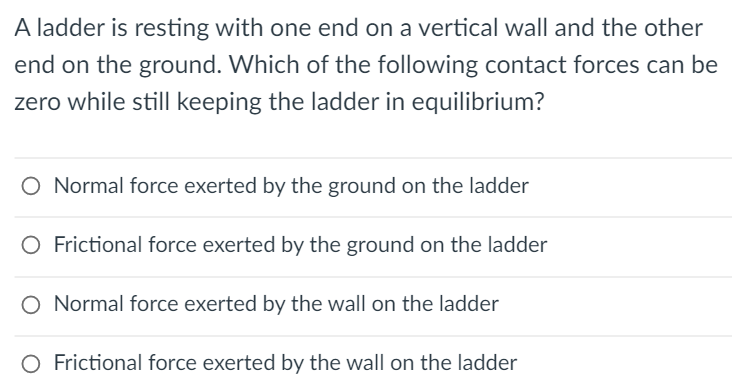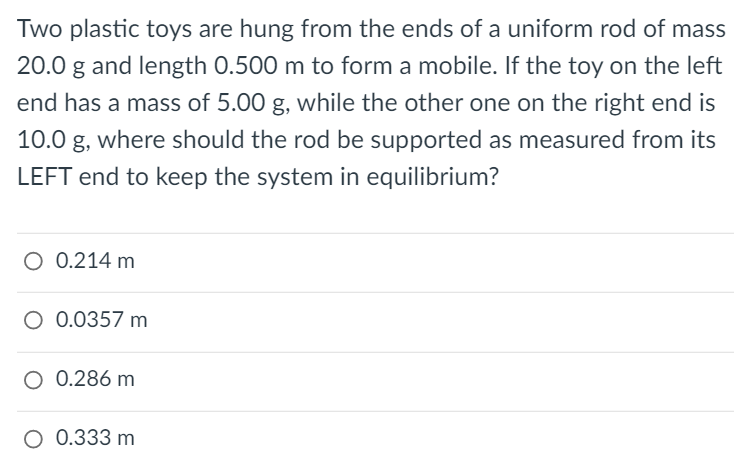A ladder is resting with one end on a vertical wall and the other end on the ground. Which of the following contact forces can be zero while still keeping the ladder in equilibrium? O Normal force exerted by the ground on the ladder O Frictional force exerted by the ground on the ladder O Normal force exerted by the wall on the ladder O Frictional force exerted by the wall on the ladder
A ladder is resting with one end on a vertical wall and the other end on the ground. Which of the following contact forces can be zero while still keeping the ladder in equilibrium? O Normal force exerted by the ground on the ladder O Frictional force exerted by the ground on the ladder O Normal force exerted by the wall on the ladder O Frictional force exerted by the wall on the ladder
Glencoe Physics: Principles and Problems, Student Edition
1st Edition
ISBN:9780078807213
Author:Paul W. Zitzewitz
Publisher:Paul W. Zitzewitz
Chapter8: Rotational Motion
Section: Chapter Questions
Problem 1STP
Related questions
Question
can you please show the correct answer and its solution?

Transcribed Image Text:A ladder is resting with one end on a vertical wall and the other
end on the ground. Which of the following contact forces can be
zero while still keeping the ladder in equilibrium?
O Normal force exerted by the ground on the ladder
O Frictional force exerted by the ground on the ladder
Normal force exerted by the wall on the ladder
O Frictional force exerted by the wall on the ladder

Transcribed Image Text:Two plastic toys are hung from the ends of a uniform rod of mass
20.0 g and length 0.500 m to form a mobile. If the toy on the left
end has a mass of 5.00 g, while the other one on the right end is
10.0 g, where should the rod be supported as measured from its
LEFT end to keep the system in equilibrium?
O 0.214 m
O 0.0357 m
O 0.286 m
O 0.333 m
Expert Solution
This question has been solved!
Explore an expertly crafted, step-by-step solution for a thorough understanding of key concepts.
Step by step
Solved in 2 steps with 1 images

Recommended textbooks for you

Glencoe Physics: Principles and Problems, Student…
Physics
ISBN:
9780078807213
Author:
Paul W. Zitzewitz
Publisher:
Glencoe/McGraw-Hill

Physics for Scientists and Engineers: Foundations…
Physics
ISBN:
9781133939146
Author:
Katz, Debora M.
Publisher:
Cengage Learning

Physics for Scientists and Engineers with Modern …
Physics
ISBN:
9781337553292
Author:
Raymond A. Serway, John W. Jewett
Publisher:
Cengage Learning

Glencoe Physics: Principles and Problems, Student…
Physics
ISBN:
9780078807213
Author:
Paul W. Zitzewitz
Publisher:
Glencoe/McGraw-Hill

Physics for Scientists and Engineers: Foundations…
Physics
ISBN:
9781133939146
Author:
Katz, Debora M.
Publisher:
Cengage Learning

Physics for Scientists and Engineers with Modern …
Physics
ISBN:
9781337553292
Author:
Raymond A. Serway, John W. Jewett
Publisher:
Cengage Learning

Physics for Scientists and Engineers
Physics
ISBN:
9781337553278
Author:
Raymond A. Serway, John W. Jewett
Publisher:
Cengage Learning

Principles of Physics: A Calculus-Based Text
Physics
ISBN:
9781133104261
Author:
Raymond A. Serway, John W. Jewett
Publisher:
Cengage Learning

College Physics
Physics
ISBN:
9781305952300
Author:
Raymond A. Serway, Chris Vuille
Publisher:
Cengage Learning